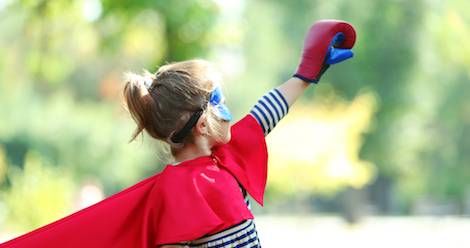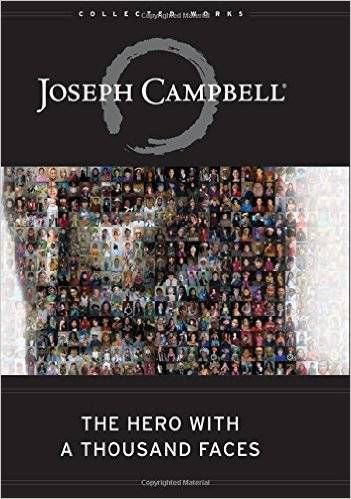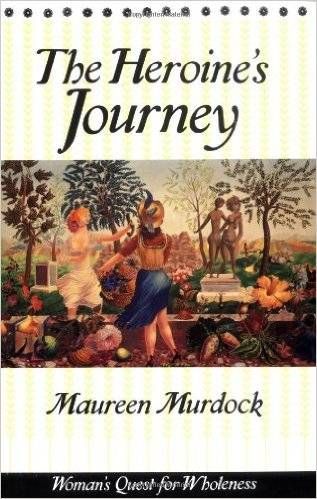
Anima House: How The Heroine’s Journey Made Me A Better Man
Like lots of people, I rolled into ninth grade literature class a mishmash of pop culture role models, peer pressure, crippling insecurities and vaulting ambition. My internal compass was a reeling mess, and my vague idea of True North was, like, some amorphous notion that I should achieve greatness. Specific, right? When Mrs. Montgomery rolled out a lesson on Joseph Campbell’s model of the monomyth, The Hero’s Journey, I felt like I’d just been given the blueprints for life. For life! Plus, when I learned how closely my beloved Star Wars trilogy followed the journey, my little mind blew up like a thousand Death Stars and I knew at once my purpose. I wanted to be a hero. I felt the call—the first giant leap on this journey.
 In case you were sick that day in ninth grade, here is a one sentence recap of the stages of heroic development according to Campbell in his The Hero With A Thousand Faces : a young dude has to work hard against adversarial forces in order to acquire some external source of power so he can become a badass once and for all and return to his people with something remarkable to show for himself. Does he have to face some internal monsters as well as external ones? Sure, somewhat. But mostly the point is to achieve success as mastery, as dominance, as power, as greatness. And he does it all for a reward.
In case you were sick that day in ninth grade, here is a one sentence recap of the stages of heroic development according to Campbell in his The Hero With A Thousand Faces : a young dude has to work hard against adversarial forces in order to acquire some external source of power so he can become a badass once and for all and return to his people with something remarkable to show for himself. Does he have to face some internal monsters as well as external ones? Sure, somewhat. But mostly the point is to achieve success as mastery, as dominance, as power, as greatness. And he does it all for a reward.
“Okay,” I said. “Cool. Let’s do this thing.” I was fourteen. Forgive me?
So I set out, keeping my eyes peeled for people from whom I could demand aid, for a weapon that would make me fearsome, for women looking to do me wrong, for a goddess to heal my wounds for me, and for an enemy to pin all my problems on.
It was miserable.
I made a bad hero, but I tried. For three decades I attempted to assert mastery over things, to force events to happen that I wanted to happen because they seemed to fit into my narrative, to sniff out monsters and sorceresses. And I told myself that if only I had that magic sword Campbell wrote about (lightsabers? Yes please!) life would be so easy and success would be inevitable. The magic elixir that Campbell wrote about was my birthright. Wasn’t it?
I got so busy trying to keep my eyes on the prize (money and fame, probably) (see also: gross) that I denied my inner life and so, to spare you a ton of details that might only bum us both out, I will leave it at this: my inner life suffered. Kind of a lot.
In suffering, in solitude, in stretches of time when life sucks so hard that we just want to slide down our bedroom door and have a long cry, we quiet down and we listen. In that stillness I heard a new call to a new adventure promising a new hope I did not find in Joseph Campbell or Star Wars or in so manny of our culture’s messages: the heroine’s journey.
 I understand I’m treading into sacred territory here, and the last thing I want is to barge in on a space dedicated for women and to colonize it. That’s not what I want at all. But, as Maureen Murdock explains in her pioneering book The Heroine’s Journey , we are all of us made up of the Jungian, archetypal masculine and feminine. These aren’t genders but rather forces within our character, aspects of ourselves called the animus and anima respectively. In the best possible circumstances they are parts working in tandem to make us whole. And that’s the point of the heroine’s journey—to heal our halves and to become complete.
I understand I’m treading into sacred territory here, and the last thing I want is to barge in on a space dedicated for women and to colonize it. That’s not what I want at all. But, as Maureen Murdock explains in her pioneering book The Heroine’s Journey , we are all of us made up of the Jungian, archetypal masculine and feminine. These aren’t genders but rather forces within our character, aspects of ourselves called the animus and anima respectively. In the best possible circumstances they are parts working in tandem to make us whole. And that’s the point of the heroine’s journey—to heal our halves and to become complete.
She lays out the shape of the heroine’s journey more or less thusly, and less as literary theory and more as self-help. But for many readers those two blur into each other in all kinds of marvelous ways, don’t they? And there are stories and myths and movies out there that illustrate it. You may think of some as you read on, and I hope you do. (If any bubble up for you, do please leave them in the comments so we can check them out!)
So. Here we go:
- Rejection of The Feminine: turning your back on your inner life, turning your back on trusting your gut instinct, turning your back on healing, on nurturing, on cultivating the Self. Bummer, right? Major bummer.
- Identification with The Masculine: embracing that competition to achieve external success—probably to fit in with or please the established patriarchy. Huge potential for more bummers, right?
- The Road of Trials: trouble with a capital T. Which rhymes with G and that stands for gathering friends and allies, because a sense of community will get you farther than aggressive mastery. That’s the upside of this stage of the quest. Unfortunately, this road can also include facing one of the most crippling trials around: your own feelings of inferiority and visits from the self-inflicted “fraud police”. BUMMER TO THE MAX. But just hang on for a minute.
- The Illusory Boon of Success: going for what you have been told to go for, and perhaps acquiring it only to find that it ain’t what you thought it was going to be (see also: many midlife crises smack of this stage) (see also: or a quarter life crisis, too) (see also: okay, you can probably be fourteen and already be at this stage, it doesn’t matter because there’s no universal timeline). An illuminating bummer that might inspire you to seek out real change? Sometimes it’s necessary. Such a time as this.
- Awakening to Spiritual Aridity: oof. OOF–that crushing feeling that your life has been gutted of its meaning. This sounds like a bummer, but this is hot on the heels of the understanding that you’ve been chasing the wrong dream so hope is within sight. Also close is the understanding that had you kept following it, you would never feel like you were enough. But you dodged that bummer by continuing the heroine’s journey, so it’s all good so far.
- The Descent: often spurred by tragedy, you go into a period of solitude to learn and get yourself right again. It can probably feel like a death—a fallow time in which Persephone is away and nothing seems to grow. But this death is temporary. While the hero also faces and must defeat death in his journey, the heroine embraces it, mourns with it, and ultimately understands it as part of herself that she must come to celebrate as something within her. Hope disguised as a bummer!
- The Urgent Yearning to Reconnect to and Reconcile With The Feminine: you have to learn to re-parent yourself sometimes, to nurture your inner child, to “develop those parts…that have gone underground during her heroic quest: her body, her emotions, her spirit, her creative wisdom,” Murdock writes. Getting in synch with your body is a huge part of this. For those using this journey as real world self-actualization it includes paying attention to your physical needs like drinking water, being active, eating the good stuff, and experiencing pleasure. Murdock also includes birthing and dying in her chapter on this stage, and it’s important for the feminine to embrace the cycles of life rather than ignore them or try to defeat them. Bummers beware, because we’re comin’ at you.
- Reincorporation of and Healing the Wounded Masculine: that part of yourself that ruled at the start of this journey is still there, and it’s probably hurting. Murdock illustrates this stage with the Fisher King from Arthurian legend. It is not likely an accident that he’s wounded in the loins. The animus, the Jungian masculine force, is one of action and outward expansion. Learning its heroic quest was the wrong course might feel like failure, or abandonment, or being a quitter—like impotence, one might say. But the Fisher King only needs tender, concerned Percival to help restore him back to health and to his place as an aid to find the Grail, which is a symbol of the feminine if ever there was one.
- The Union: synthesis! Balance! Internal wholeness and deep fortitude! However the work isn’t done and is never done, but just keep swimming because you totally got this.
That’s a lot to cover in a short span, and I wholeheartedly urge you to check out the book for lengthier, lovelier explanations. But there it is, succinctly as I can put it.
“The challenge of the heroine,” Murdock writes, “is not one of conquest but of acceptance, of accepting her nameless, unloved parts.” We don’t live in a world that goes out of its way to help us out on this quest, or even assigns a whole lot of value to it. The portion of the heroine’s journey Murdock calls The Road of Trials includes pressure from a patriarchal culture that at every dinner party or first date over coffee wants to know what we do, and in what ways we are valuable. What about what we are? “Being is not a luxury,” says Murdock. “It’s a discipline.” What the hero fails to see, the heroine cannot ignore—she must truly see herself, know herself, and she must reconcile and heal her wounds before rising to great occasions. Rise she will; rise she must. That’s life. But first–the descent.
“Okay,” I said those many months ago. “Cool. Let’s do this thing.” I descended, like a heroine.
Heroes descend, too. There is often a trip to the local Underworld or belly of the beast to pick up a few things on their way home. These things frequently include victory by combat or by ordeal. Also, the world below is one to be feared—full of hidden foes and unseen monsters. (Um. Yes, Hero, that’s called “the psyche”. Look it up sometime.)
The feminine has been forced underground for a long, long time. Feminine earth religions, frequently usurped by masculine sky religions (check out the scuffle over Delphi in Greek myth, for instance), have moved into humanity’s basement more often than they haven’t. The heroine’s journey takes us home, below the noisy business of the world, where we find not a foe but a friend: our best self.
Embarking on the heroine’s journey doesn’t mean that you don’t or can’t have dreams or goals or things you hope to accomplish outside of yourself, of course. And it doesn’t mean that you have to be female. I found that by paying careful, loving attention to the malnourished parts of my character I could engage in life as a fuller, richer, stronger version of myself. But it had to happen first; I had to descend.
The heroine taught me so much. She taught me about the success of healing. She taught me that the only magical sword you will ever need is your rejuvenated spirit and revived comfort within your self, and that those will give you greater creative agency than you might have dreamed is possible. She taught me that facing inner monsters teaches you unshakable courage. She taught me that friendship and compassion serve you more than asserting your dominance. She taught me the way is from the inside out, and I’m still rising, and still learning, and still healing but holy hell I have never felt more confident that I’m moving nearer to something true, good, and lasting—a life as a better man.











